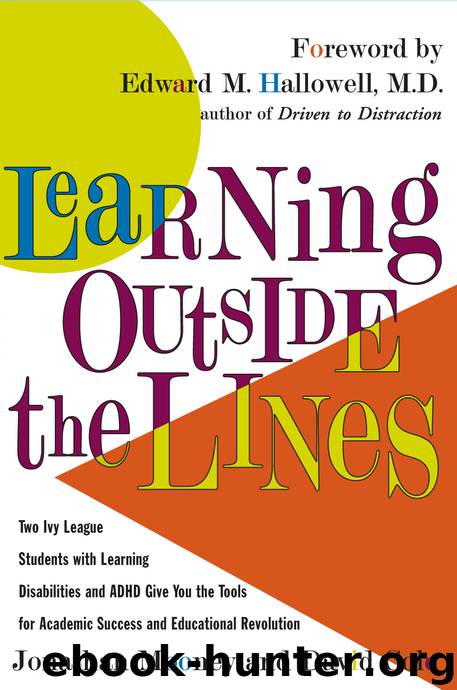Learning Outside The Lines by Jonathan Mooney

Author:Jonathan Mooney
Language: eng
Format: epub, mobi
Publisher: Touchstone
SECTION 3: READING EVERYTHING ELSE
As the heading implies, we are on the home stretch, and all that remains is to look at some specific specialized reading methods for types of reading that may not be totally covered in the first two sections. What follows are three specialized reading approaches: the focused skim, reading like Einstein (especially for chemistry majors), and fast fiction.
One last word: Keep in mind that these specialized reading methods are not designed to stand on their own. To maximize their effectiveness, use them in tandem with the methods outlined in Sections 1 and 2. With that said, come on down to the art of the focused skim.
The Art of the Focused Skim
The art of the focused skim is a long-practiced tradition by students who blow off reading, get great grades, and learn more than anyone else. We used to hate these people, but now we know their secret.
The goal of this method is to get very specific types of information from a large reading (that you have or have not done; who cares?) in a very short amount of time. This skill is key for cramming for an exam, researching for papers, and for straight up dominating discussion. It works for any type of reading with the exception of fiction, and all you need in front of you is the reading in question. ETA: 5 to 15 minutes, depending on the amount and type of information you are looking for.
1. Clarify what you are looking for. The key to good focused skimming is to articulate clearly in your own mind what you are searching for. Get as specific as possible. For example, if you start out looking for sex, try to articulate what exactly you’re searching for. Are you looking for sexual positions? The history of S&M? Roman orgies? Or are you looking for the obvious and commonly known fact that Irish men are vastly superior to the average? Regardless, try to focus your search, and be as specific as possible. It will make life much easier.
2. Think about context. Think about how this information might be situated in the text. Think about what type of information it is: a term? date? event? theory? Each of these has its own markings inside the text. Also think about what type of information may surround what you are looking for.
3. Don’t read yet! Don’t jump right into the search head first. Take a minute. Alternative sources are a perfect way to get around the time-consuming act of reading. Go to your syllabus, and see if you can home in on a day where what you are looking for was discussed or addressed in class. If so, go to your notes for that day and scan for your cues. If you find gold, see if you can stop right there. Going to the syllabus is also useful if you are unsure what text to look in. Repeat: Note the readings that were assigned for the lecture. After the syllabus and note search, drop an e-mail to your prof or a peer.
Download
Learning Outside The Lines by Jonathan Mooney.mobi
This site does not store any files on its server. We only index and link to content provided by other sites. Please contact the content providers to delete copyright contents if any and email us, we'll remove relevant links or contents immediately.
The Art of Coaching Workbook by Elena Aguilar(50990)
Trainspotting by Irvine Welsh(21520)
The Secret History by Donna Tartt(18851)
Twilight of the Idols With the Antichrist and Ecce Homo by Friedrich Nietzsche(18504)
All the Missing Girls by Megan Miranda(15581)
Cat's cradle by Kurt Vonnegut(15187)
Ready Player One by Cline Ernest(14527)
Talking to Strangers by Malcolm Gladwell(13224)
Fangirl by Rainbow Rowell(9098)
The remains of the day by Kazuo Ishiguro(8826)
The Compound Effect by Darren Hardy(8812)
Thirteen Reasons Why by Jay Asher(8797)
Tools of Titans by Timothy Ferriss(8219)
Periodization Training for Sports by Tudor Bompa(8171)
Wonder by R. J. Palacio(8011)
The Lover by Duras Marguerite(7831)
A Court of Wings and Ruin by Sarah J. Maas(7653)
Change Your Questions, Change Your Life by Marilee Adams(7636)
The Complete Stick Figure Physics Tutorials by Allen Sarah(7309)
